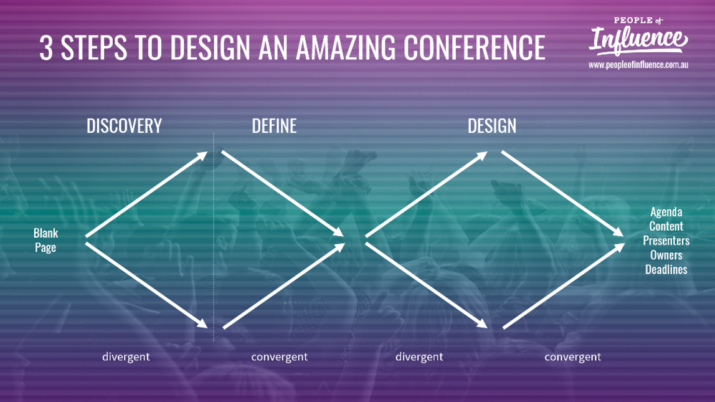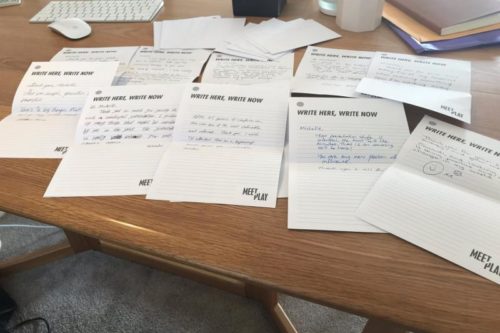Got a conference coming up? It’s getting to be that time of year.
Maybe your organisation, team or business unit will be having their annual conference in a couple of months and you have been tasked as being a member of the ‘organising committee’. Or maybe you are going to be a participant but feel a vested interest in helping this gathering be an enjoyable and valuable event for participants and the business. Either way, we want to give you a systematic way of thinking about this next event to ensure it is actually worthwhile.
My colleagues and I at People of Influence, have spoken at and facilitated hundreds of conferences around the world: in Europe, the US and especially Australia and Asia. The most common way clients engage us is they come to us with a blank page and say ‘we have a conference coming up…now what?’ To be clear, we aren’t an event company – we don’t book the flights, decide on the table settings or supply the lapel mics. Our job is to craft the agenda, the content and the experience that we then facilitate from the front of the room.
So I thought I’d give you a peek into how we do this: a taster of our methodology and some tips as to how you can design your conference, with a process that sets you up for success. Before I start I should let you know that my business partner, Shaun Kenny, has created a short (and entertaining) video about how to do this and you can watch it HERE (you know, if reading isn’t your thing).
What’s the Problem?
It’s very rare for those who are planning, organising or paying for events to have a sound approach to designing them. As a result, outcomes are often (usually) substandard.
What happens is either:
- The ‘Paint By Numbers’ Approach – they do what they did last year. Rinse and repeat. This saves time, but it hardly leads to an inspiring result!
- The ‘Reinvent the Wheel’ Approach – they start from scratch every time. It is a time suck, it’s stressful, everyone has an opinion and they are kind of making it up as they go along without being sure if there is a better way they could be approaching the task. This approach can span weeks or even months.
What’s the Solution?
The solution is to rally your organising committee around a methodology that is both repeatable and efficient, yet simultaneously helps facilitate creativity and innovation. To achieve this for our clients we developed a process that borrows from our expertise in ‘human-centred design’.
It looks like this.
Phase One: Discovery
The Discovery Phase is a divergent process, meaning you are trying to capture as diverse a range of ideas from the stakeholders to the conference: the boss(es), external sponsors and especially the participants/audience. There are two common mistakes in this phase: the first is not considering all perspectives when deciding the objectives of the event. The second is not really, truly, deeply understanding the audience. You must start with empathy.
Phase Two: Define
The Define Phase is a convergent process, meaning you are now trying to converge on one view. Firstly, you want to define what success looks like as tangibly as possible (objectives). Secondly, you want to understand what could (and has in the past) get in the way of success (obstacles). This second part is a process of trying to see ‘submerged icebergs’ that could sink your event if you don’t anticipate them and design for them!
Phase Three: Design
The Design Phase has both a divergent and convergent part. The divergent step is about generating ideas (as many creative ideas as possible) as to how to achieve the objectives decided upon in the Define Phase. The convergent step is about selecting ideas to shape into an agenda (the how), content (the what), the presenters/facilitators and owners of each agenda item (the who) and the next steps (the when).
Some good news
While this may look daunting if you aren’t familiar with a process such as this, it can actually be very time efficient. This process can be completed in one day (yes, one day) if two conditions are met:
- Discovery has been gathered (through stakeholder interviews and surveys) ahead of the design day.
- The right people are in the room (the ultimate decision makers must be present for some of the design discussion and for sign-off).
Hang on, why should I be doing this again?
In summary, the benefits:
- Increases the quality of the product (the conference) and saves massive amounts of time.
- You can document the process and then communicate the planning (through video and other forms) ahead of the conference, to build anticipation about the event.
- If you include the right people in this process, you have created buy-in and ownership from key influencers; you have champions who can spread the word and build excitement ahead of the conference and who show up on the day with the right energy and engagement.
I hope that helps! Happy conference planning!
—
Want more?
If you haven’t already, check out the 5 minute video where Shaun goes through these steps, or visit our leadership development and extraordinary teams for ideas on engaging off-sites and events.




